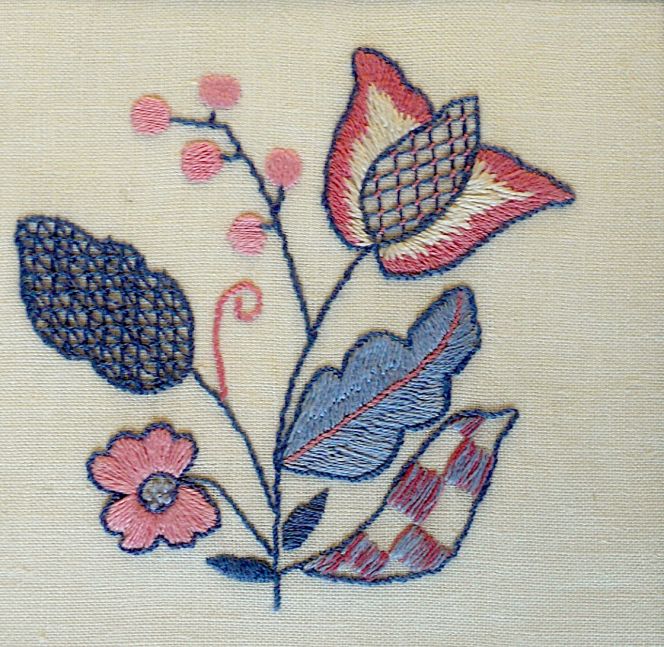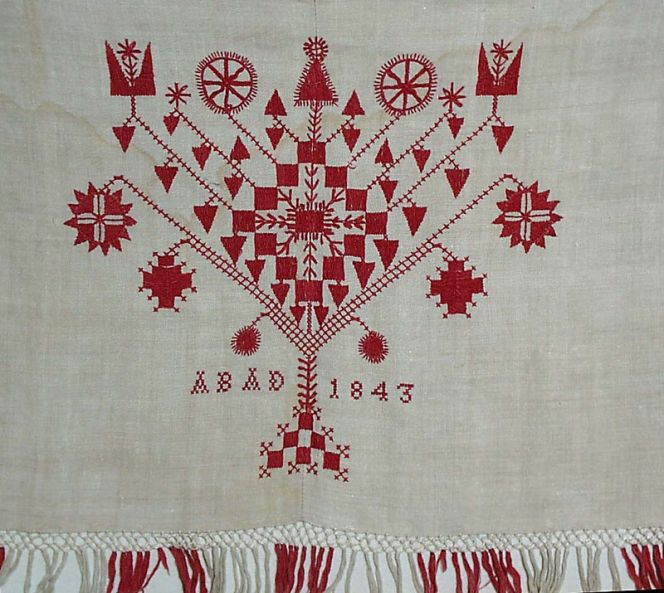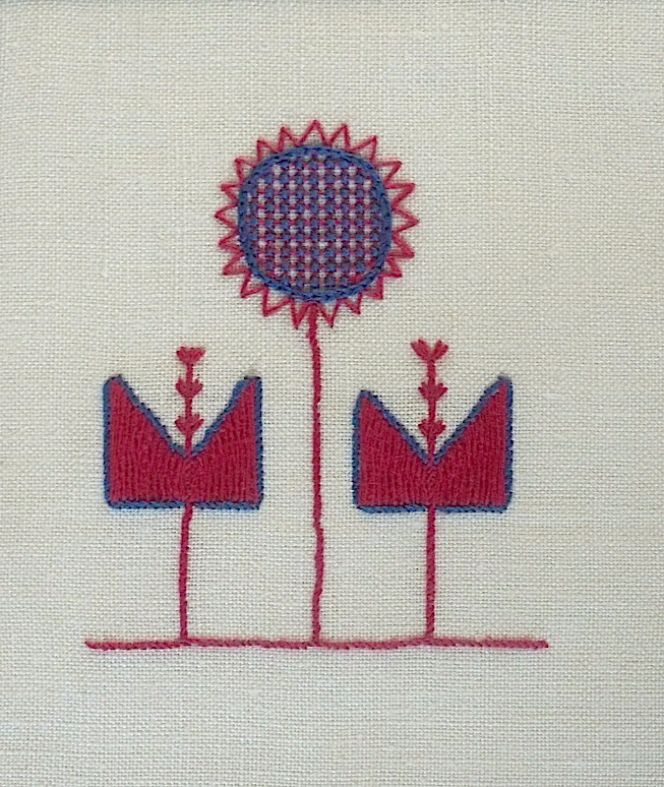ikfoundation.org
Promoting Natural & Cultural History



ESSAYS |
HISTORICAL REPRODUCTIONS
– Local Swedish Embroideries
Many areas in Sweden developed their own specialised embroidery designs in various combinations depending on material, stitching, colours and practical uses in the 18th- and 19th centuries. Three of these local county embroidery styles have been discussed in earlier historical essays, and here, the aim is to share the history of three further local specialities. As in earlier texts, the knowledge and experience of the subject are based on my reproductions of details from these embroideries, together with a brief history and material analysis of each type known from previous research and museum collections’ notes.
 Embroidered pillow-case with 1-ply machine-spun cotton thread on cotton fabric, dated 1877 in so-called Delsbosöm; Delsbo district in Hälsingland, Sweden. As interestingly noted by the Nordic Museum: ‘The letter “H” in front of the female initials was common in Hälsingland and stand for “Hustru”(Wife). The letter “I” in the same way means “Jungfru”(Maid), accordingly an unmarried woman’. (Courtesy of: Nordic Museum, Stockholm, NM.0144066, & historical facts & translated quote from catalogue card).
Embroidered pillow-case with 1-ply machine-spun cotton thread on cotton fabric, dated 1877 in so-called Delsbosöm; Delsbo district in Hälsingland, Sweden. As interestingly noted by the Nordic Museum: ‘The letter “H” in front of the female initials was common in Hälsingland and stand for “Hustru”(Wife). The letter “I” in the same way means “Jungfru”(Maid), accordingly an unmarried woman’. (Courtesy of: Nordic Museum, Stockholm, NM.0144066, & historical facts & translated quote from catalogue card). Historical reproduction of Delsbosöm on linen with 2-ply cotton thread (satin- & stem stitches). As the original, the detail is primarily embroidered in one-sided satin stitching totally covering the motifs on the front, while only tiny seed stitching is visible on the back. Photo and embroidery: Viveka Hansen.
Historical reproduction of Delsbosöm on linen with 2-ply cotton thread (satin- & stem stitches). As the original, the detail is primarily embroidered in one-sided satin stitching totally covering the motifs on the front, while only tiny seed stitching is visible on the back. Photo and embroidery: Viveka Hansen.The above embroidered original and reproduction show Långsöm, a type of design done with one-sided satin stitching, introduced in Hälsingland – mid-Sweden – around 1840. However, at the turn of the century 1900, this sort of embroidery started to be called Delsbosöm (stitching from Delsbo) by the contemporary Handicraft movement “Hemslöjden” for the reason that the technique was most popular by the women around the town Delsbo in that particular district. These textile decorations were primarily used to embellish pillowcases, tablecloths, wall hangings and bed linen. Furthermore, during the 1960s, a substantial number of patterns cut in paper and birch bark depicting stars, flowers, crowns, birds and baskets were rediscovered in Delsbo – ones used for sketching out the desired motifs on the fabric. The used motifs belong to an often replicated combination of patterns in Swedish folk art, but the inspiration/origin of the actual design in the Delsbosöm is uncertain.
 Linen wall-hanging embroidered with cotton thread and dated 1848 in so-called Blekingesöm; Blekinge, Sweden. (Courtesy of: Nordic Museum, Stockholm, NM.0232890, & historical facts from catalogue card).
Linen wall-hanging embroidered with cotton thread and dated 1848 in so-called Blekingesöm; Blekinge, Sweden. (Courtesy of: Nordic Museum, Stockholm, NM.0232890, & historical facts from catalogue card). Historical reproduction of Blekingesöm on linen with 2-ply linen thread (satin & stem stitches, variation of interlacing stitching & French knots). Photo and embroidery: Viveka Hansen.
Historical reproduction of Blekingesöm on linen with 2-ply linen thread (satin & stem stitches, variation of interlacing stitching & French knots). Photo and embroidery: Viveka Hansen.The above-depicted detail of the wall-hanging embroidered 1848 and the reproduction of the same Blekingesöm belong to a more free embroidery style, which makes one think of inspiration from East Indian fabrics and porcelain. While this stitching design is considered to have been introduced in the 1780s within vicarage families in the district of Blekinge in southern Sweden, it is highly probable that East Indian influences can be considered. The Swedish East India Company (1731-1813) had been trading for more than 50 years at this time and had had good opportunities to sell/spread their goods to influential groups of the society – from the kings and nobles, wealthy bourgeois, priesthood and comfortable farmers.
Furthermore, the combination of stitching, advanced design of the motifs and large-size embroideries demanded a trained hand, and this often meant professional female embroiderers who stitched these decorative interior textiles, searching their presumptive customers by walking around to farmer’s homes, townhouses etc. The embroidery design was extremely popular, with a peak around the 1790s to 1840s. The structure of the used colours also differs from other Swedish local folk embroideries, while pink, red, yellow, light- and dark-blue cotton dominate in the Blekingesöm. This is in contrast with most other Swedish folk art embroideries, including contrasting red, yellow, white, black, green, and blue, or one/two colours only.
 Linen wall-hanging embroidered with linen thread, dated 1843; Förlanda parish, Fjäre district, Halland, Sweden. (Courtesy of: Nordic Museum, Stockholm, NM.0076448, & historical facts from catalogue card).
Linen wall-hanging embroidered with linen thread, dated 1843; Förlanda parish, Fjäre district, Halland, Sweden. (Courtesy of: Nordic Museum, Stockholm, NM.0076448, & historical facts from catalogue card). Historical reproduction of Hallandssöm on linen with 2-ply cotton thread (cross stem, chain & lattice stitches & variation of herringbone stitching). Photo and embroidery: Viveka Hansen.
Historical reproduction of Hallandssöm on linen with 2-ply cotton thread (cross stem, chain & lattice stitches & variation of herringbone stitching). Photo and embroidery: Viveka Hansen.The two final images depict Hallandssöm or the stitching from Halland (in southern Sweden), both showing variations of the tree of life in strict shapes with the stitching following the threads of the linen fabric. The technique was used for household linen like pillowcases, but also for decorative wall-hangings, first and foremost during festivities to adorn the farmer’s walls and ceiling in the main room. Most preserved textiles of said type originate from the mid-19th century and the following decades and are dominantly embroidered with red or strong pinkish cotton thread – named Turkish red.
Sources:
- DigitaltMuseum (several examples of these embroidery designs are kept in Swedish museums).
- Hansen, Viveka, ‘Textilt överflöd från gamla blekingska hem – En textilhistorisk undersökning av bouppteckningar 1770-1870’, Blekingeboken, 1998, pp. 131-49.
- Hansen, Viveka (Historical reproduction/embroideries).
- Melén, Lisa, Landskapssömmar, Västerås 1970.
ESSAYS
The iTEXTILIS is a division of The IK Workshop Society - a global and unique forum for all those interested in Natural & Cultural History from a Textile Perspective.
Open Access essays - under a Creative Commons license and free for everyone to read - by Textile historian Viveka Hansen aiming to combine her current research and printed monographs with previous projects dating back to the late 1980s. Some essays also include unique archive material originally published in other languages, made available for the first time in English, opening up historical studies previously little known outside the north European countries. Together with other branches of her work; considering textile trade, material culture, cloth manufacturing, fashion, natural dyeing and the fascinating world of early travelling naturalists – like the "Linnaean network" – from a Global history perspective.
For regular updates, and to make full use of iTEXTILIS' possibilities, we recommend fellowship by subscribing to our monthly newsletter iMESSENGER.
been copied to your clipboard




– a truly European organisation since 1988
Legal issues | Forget me | and much more...
It is free to use the information/knowledge in The IK Workshop Society so long as you follow a few rules.
 LEARN MORE
LEARN MORE








